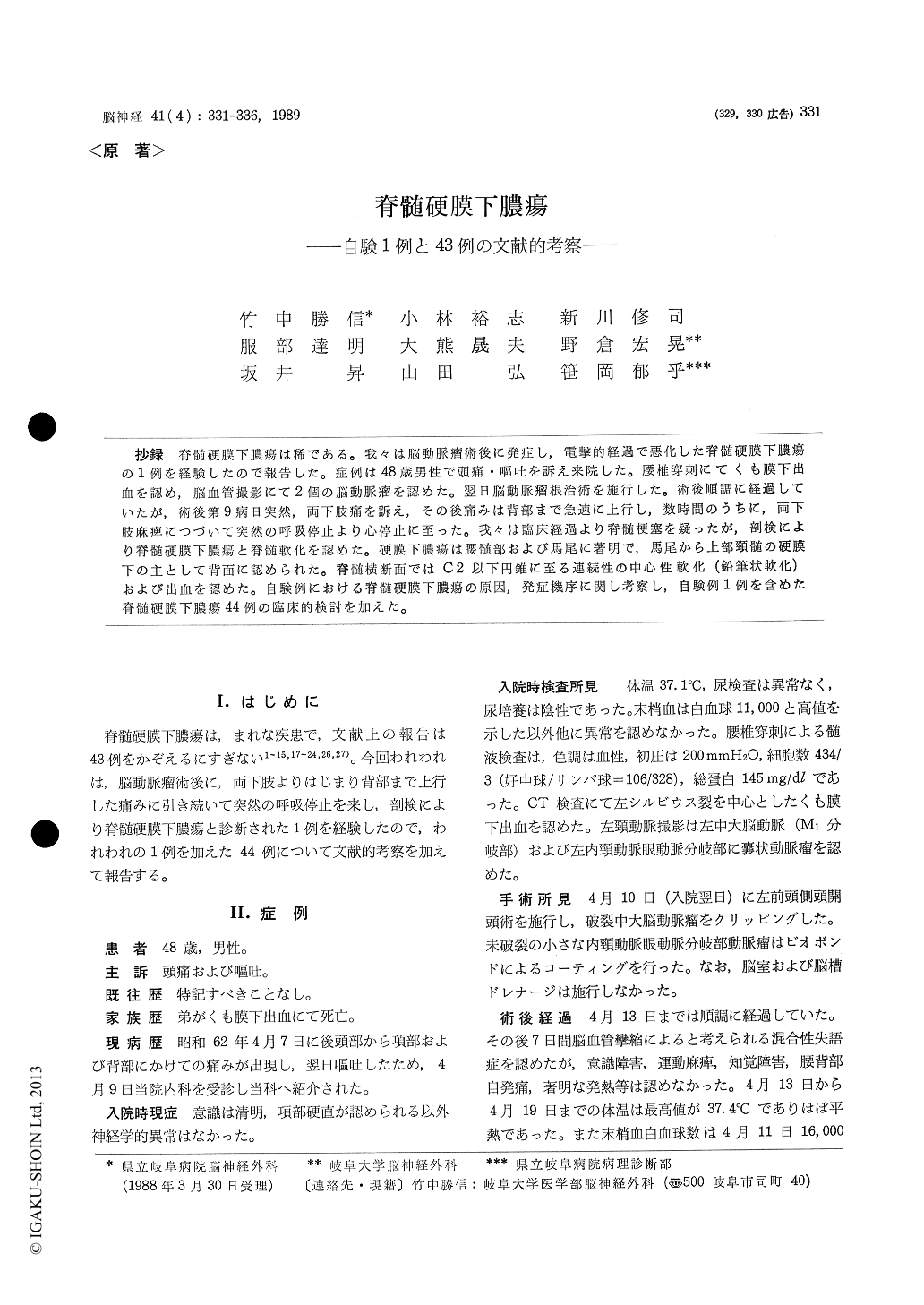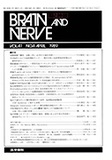Japanese
English
- 有料閲覧
- Abstract 文献概要
- 1ページ目 Look Inside
抄録 脊髄硬膜下膿瘍は稀である。我々は脳動脈瘤術後に発症し,電撃的経過で悪化した脊髄硬膜下膿瘍の1例を経験したので報告した。症例は48歳男性で頭痛・嘔吐を訴え来院した。腰椎穿刺にてくも膜下出血を認め,脳血管撮影にて2個の脳動脈瘤を認めた。翌日脳動脈瘤根治術を施行した。術後順調に経過していたが,術後第9病日突然,両下肢痛を訴え,その後痛みは背部まで急速に上行し,数時間のうちに,両下肢麻痺につづいて突然の呼吸停止より心停止に至った。我々は臨床経過より脊髄梗塞を疑ったが,剖検により脊髄硬膜下膿瘍と脊髄軟化を認めた。硬膜下膿瘍は腰髄部および馬尾に著明で,馬尾から上部頸髄の硬膜下の主として背面に認められた。脊髄横断面ではC2以下円錐に至る連続性の中心性軟化(鉛筆状軟化)および出血を認めた。自験例における脊髄硬膜下膿瘍の原因,発症機序に関し考察し,自験例1例を含めた脊髄硬膜下膿瘍44例の臨床的検討を加えた。
Spinal subdural abscess is rare, compared with spinal epidural abscess.
The first case was reported by Sittig in 1927. Only 43 cases have been reported throughout the literature.
We experienced an atypical fulminant case of spinal subdural abscess, following the operation for intracranial aneurysms.
The patient was a 48-year-old male, admitted to our hospital on April 9, 1987 with complaining of sudden headache and vomiting. A lumbar puncture proved subarachnoid hemor-rhage (S. A. H.), CT scan revealed sacular ane-urysms in left middle cerebral artery and left inter-nal carotid-opthalmic artery. Radical surgical treat-ment for those aneurysms was undergone success-fully. Neither cerebral ventricular nor cisternal drainage was established.
His postoperative course was uneventful until the 9 th postoperative day. He suddenly com-plained of pain in his legs and back, followed by paraplegia, respiratory, and cardiac arrests with clinical course of several hours.
Antibiotics had been used for eight days after surgery, and there was no clinical evidence of inflammation sign.
For his abrupt aggravation, a spinal infarction was suspected. However, the autopsy demonstrat-ed that the dorsal side of the entire spinal cord was covered with masses of pus, and central nec-rosis and hemorrhage of the spinal cord mainly occupied the central gray matter ; so-called Pen-cilsharped softening.
In this case, the cause of spinal subdural abscess was unclear. But the lumbar puncture performed on the day of admission, was most responsible. Also, the reasons why the clinical course of our case was rapid and fulminant were discussed with pre-ference of spinal abscess to primary spinal circular disorder.
44 cases in the literature, including the pre-sented report, was reviewed. Those symptomato-logy, predisposing factors, pathogenesis, the extent of spinal subdural abscess, clinical diagnosis, treat-ment, and prognosis were discussed.
Among previous cases, this case was one of the most extensive subdural abscess and fulminant clinical course.

Copyright © 1989, Igaku-Shoin Ltd. All rights reserved.


